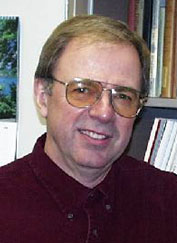Faculty Emeritus: A. Alan Pinkerton

Emeritus and Distinguished University Professor
Email: a.pinkerton@utoledo.edu
Office: WO 2237
Phone: (419) 530-4580
Fax: (419) 530-4033
Professional Background:
Graduate, 1966, Royal Institute of Chemistry (England);
Ph.D., 1971, University of Alberta (Canada);
Postdoctoral Fellow
1971-72, University of Sussex (England);
1972-74, Universté de Lausanne (Switzerland);
1974-76, Faculté Des Sciences, Nice (France);
Premier Assistant, 1976-78, Université de Lausanne (Switzerland);
Maître Assistant/Privat Docent, 1978-84, Université de Lausanne (Switzerland)
View Dr. Pinkerton's Publications
Research Synopsis:
Inorganic Chemistry/X-ray Crystallography:
Inorganic Chemistry/X-ray Crystallography:
X-ray crystallography - The use of X-ray crystallography to solve chemical problems
is well developed. Using extensive low temperature X-ray diffraction data it is possible
to go far beyond the simple determination of molecular structures. We are able to
map the entire electron density distribution in molecules and thus obtain information
on chemical bonding previously only available from quantum mechanics. Any one-electron
property is available given the atomic arrangement and the electron density distribution.
In the simplest cases we may obtain atomic charges, or the orientation of lone pairs.
This information is also used to map the molecular electrostatic potential, which
tells us the direction of electrophilic or nucleophilic attack, or how a molecule
would interact with a biological receptor (molecular recognition). From the complete
topological analysis of the electron density, we are able to determine energy density
distributions, and the energy of intermolecular interactions, not only the dissociation
energy of hydrogen bonds, but also that of weaker interactions, e.g. O¡O, O¡N, H¡H.
Current studies examine the deformation of the pi-electron density due to pyramidalized
sp2 carbon in a series of organic molecules, the charge density distribution in high
energy (explosive) molecules to understand shock sensitivity, and the electrostatic
potential of estrogens in order to understand binding affinities to the estrogen receptor,
and the initiation step for developing breast cancer. Variable temperature diffraction
experiments allow us to determine the thermal expansion tensors of materials which,
coupled with compressibility studies, lead us to equations of state.
In addition, we are developing new techniques to exploit the cutting edge diffraction
hardware available to us, e.g. we have recently described a new cooling device using
liquid helium and have benchmarked a new image plate detector for the rapid measurement
of electron density quality data.
Much of our research is carried out in collaboration with other groups, either in
national laboratories or at other universities around the globe.


